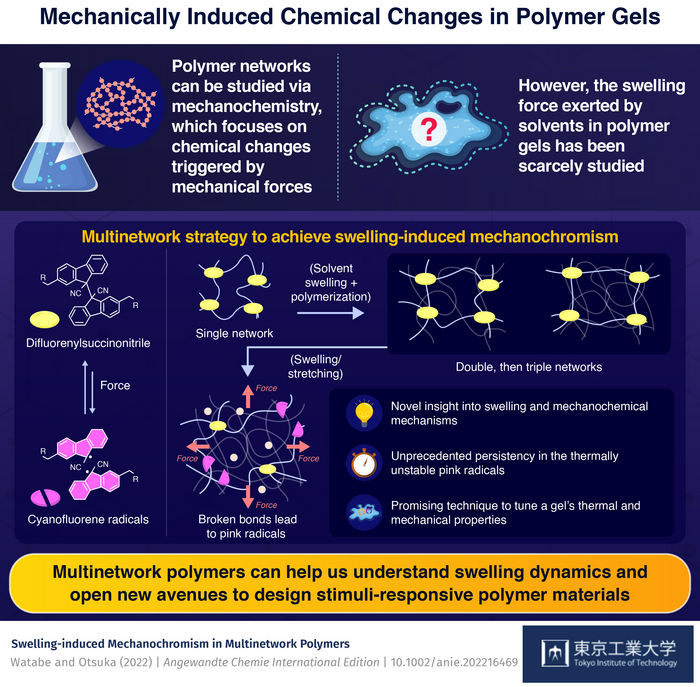Polymer gels have become a standard technique in many areas, including optics, drug delivery, carbon capture, and batteries. Yet, several issues about gels and their network structure remain unresolved, preventing researchers from connecting their unique macroscopic features to specific molecular mechanisms.

Image Credit: Tokyo Institute of Technology
One intriguing approach to this puzzle is to examine it from the perspective of mechanochemistry, which refers to chemical reactions induced by mechanical stimuli like compression, stretching, and grinding.
To facilitate this process, researchers can incorporate mechanophores into polymer networks. When exposed to mechanical stress, these molecules undergo expected chemical changes. While there are numerous methods for applying mechanical stresses to activate mechanophores in a gel, one has received far less attention than others: solvent swelling.
Inspired by this knowledge gap, a pair of Tokyo Institute of Technology (Tokyo Tech) investigators in Japan opted to concentrate on swelling-induced mechanochromism (or color change caused by mechanical stimuli) in polymer gels.
The scientists used an innovative strategy in their most recent study, published in Angewandte Chemie International Edition, to create a gel very sensitive to the mechanical forces stimulated by solvent swelling while also displaying a noticeable color change upon activation of carefully chosen mechanophores.
The method in question is based on the formation of a multinetwork polymer. This procedure begins with creating a first network in which polymer chains are joined by a mechanophore known as difluorenylsuccinonitrile (DFSN). The first network is then packed and extended with monomers, which serve as the building blocks for a second network that is interwoven with the first.
After repeating the former step and adding a third network, the original first network is extended to the point where the DFSN linkers can be broken by even a minor increase in volume induced by solvent swelling. Most crucially, when the DFSN mechanophores divide into cyanofluorene (CF) radicals, they turn pink, which can be seen macroscopically.
The researchers were able to investigate and contrast the swelling caused by different solvents on several kinds of multinetwork polymers using this novel strategy. They also looked into the disparities in mechanical activation produced by solvent swelling and one-way stretching, in addition to changes in DFSN’s thermal reactivity.
Furthermore, they investigated why the pink CF radicals were so stable, despite thermodynamic theory predicting that they would recombine into the original DFSN linkers over time. It is worth mentioning that the findings for the polymers utilized in this study apply to other compounds as well.
The studied phenomenon are not limited to multinetwork polymer systems; they can also be observed in other polymers with unique conformations, such as polyelectrolytes and topologically complex polymers.
Hideyuki Otsuka, Study Corresponding Author and Professor, Tokyo Institute of Technology
The results of this research provide some much-needed insight into the swelling process in polymer networks. As a result, unique material designs may emerge.
The swelling force-induced mechanochemical reactions and enhanced thermal reactivity demonstrated in our work illustrate that the use of multinetwork polymers not only contributes to our understanding of swelling dynamics, but also opens new avenues for the design of stimuli-responsive polymer materials.
Hideyuki Otsuka, Study Corresponding Author and Professor, Tokyo Institute of Technology
A better understanding of mechanochemistry will open the way for novel functional gels for various applications.
Journal Reference:
Watabe, T.& Otsuka, H. (2022) Swelling-induced Mechanochromism in Multinetwork Polymers. Angewandte Chemie International Edition. doi.org/10.1002/anie.202216469.